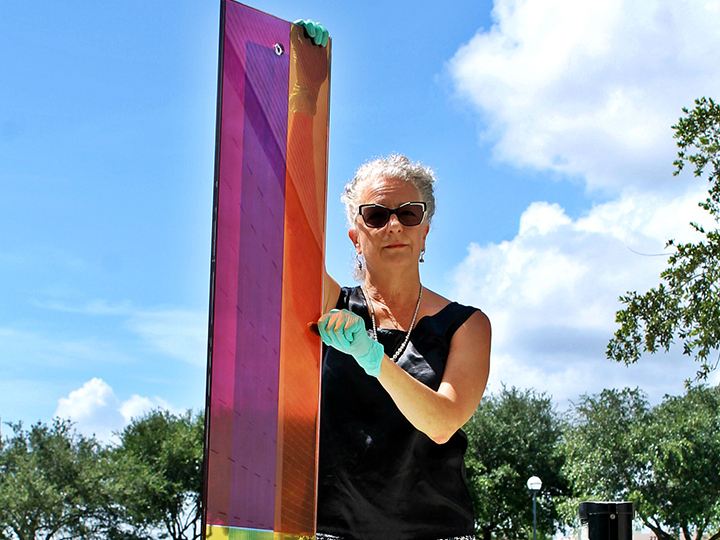

Visitors to the University of Houston-Victoria will be captivated by a new installation by internationally known artist Margo Sawyer. “Synchronicity of Color: Victoria” now hangs from the ceiling in the three-story high atrium of the University North building.
The artwork consists of seven hand-painted laminated glass elements suspended from the ceiling. Positioning of the artwork adjacent to the staircase allows observers to experience the rich color, textured patterns, subtle movement and the contemplative nature of the artwork from varying perspectives.
“They unite an array of complex and unexpected unions of color,” said Sawyer, a 2018 Guggenheim Memorial Foundation Fellow. She describes it as “an optical color play, transparency, reflectivity, luminosity, physicality, materiality, perceptual, material and the psychological effects of color as a window into our emotions.”
In this and other works from the ongoing “Synchronicity of Color” series, such as the celebrated “Synchronicity of Color: Red and Blue” at Discovery Green in Downtown Houston, Sawyer is concerned with color as subject and matter.
“The displacement of color-infused light onto this multi-leveled space is one of the elements making this work so spectacular,” said María C. Gaztambide, director and chief curator, Public Art of the University of Houston System. “Margo Sawyer’s work reflects a long-standing commitment to color as the vehicular medium for investigating the relationship between site-specific art and architecture. It is simply stunning, and we are delighted to share it with audiences in and beyond Victoria.”
Famed psychologist Carl Jung’s concept of “synchronicity,” or meaningful coincidences, also provides Sawyer with a powerful muse for her artistic practice. In “Synchronicity of Color: Victoria” the notions of space and transcendence come together beyond mere coincidence.
“Architecture and ritual can converge to create unique and memorable experiences, capable of restoring a quality of contemplation within our lives,” said Sawyer. “I hope ‘Synchronicity of Color: Victoria’ can gift this contemplative presence to members of the Victoria community.”
"Synchronicity of Color: Victoria” is UHV’s first commissioned art installation in more than a decade. The piece was installed under a program established in 1966 by the Board of Regents of the University of Houston to set aside one percent of construction costs of all new building projects to acquire works of art. In 1969, the Texas Legislature approved the Percent for Art program and that same year the University of Houston became the first public university in Texas to formally adopt it. Nearly 50 years later, Public Art of the University of Houston System has close to 700 works and is one of the most impressive collections in the country.
“UHV is honored to receive this lovely art installation from Margo Sawyer and Public Art of the University of Houston System,” said Robert Glenn, UHV president. “A university campus is a place to encourage learning and unity, and this piece will speak to our students, faculty, staff and community and encourage them to pursue those values.”
More about Margo Sawyer:
Sawyer was born in the U.S. and raised in England. Her work focuses on the experience of space and transcendence. It also reflects the long artistic lineage of abstraction and historical links to the Russian Constructivists, the De Stijl Movement, and to artists including Piet Mondrian, Le Corbusier, Joseph Albers and Donald Judd, to name a few. Sawyer’s work has been exhibited in national and international locations including New York, Los Angeles, New Haven, Houston, Dallas, Austin, the United Kingdom, Italy, India and Japan.
More about the fabrication process:
To create the installation for UHV, Sawyer spent two years working with Franz Mayer of Munich. This 5th Generation German company is the leading specialist in the production of architectural glass and mosaics. The individual glass pieces were designed using computer models to create stencils employed in the painting process. Pigments of ground glass were airbrushed onto the panels, which were then fired in a kiln. Afterward, a second layer of color was brushed on by hand, and the panel was fired again. Franz Mayer designed special hardware and cables that are structural and visually non-intrusive to the artworks.
